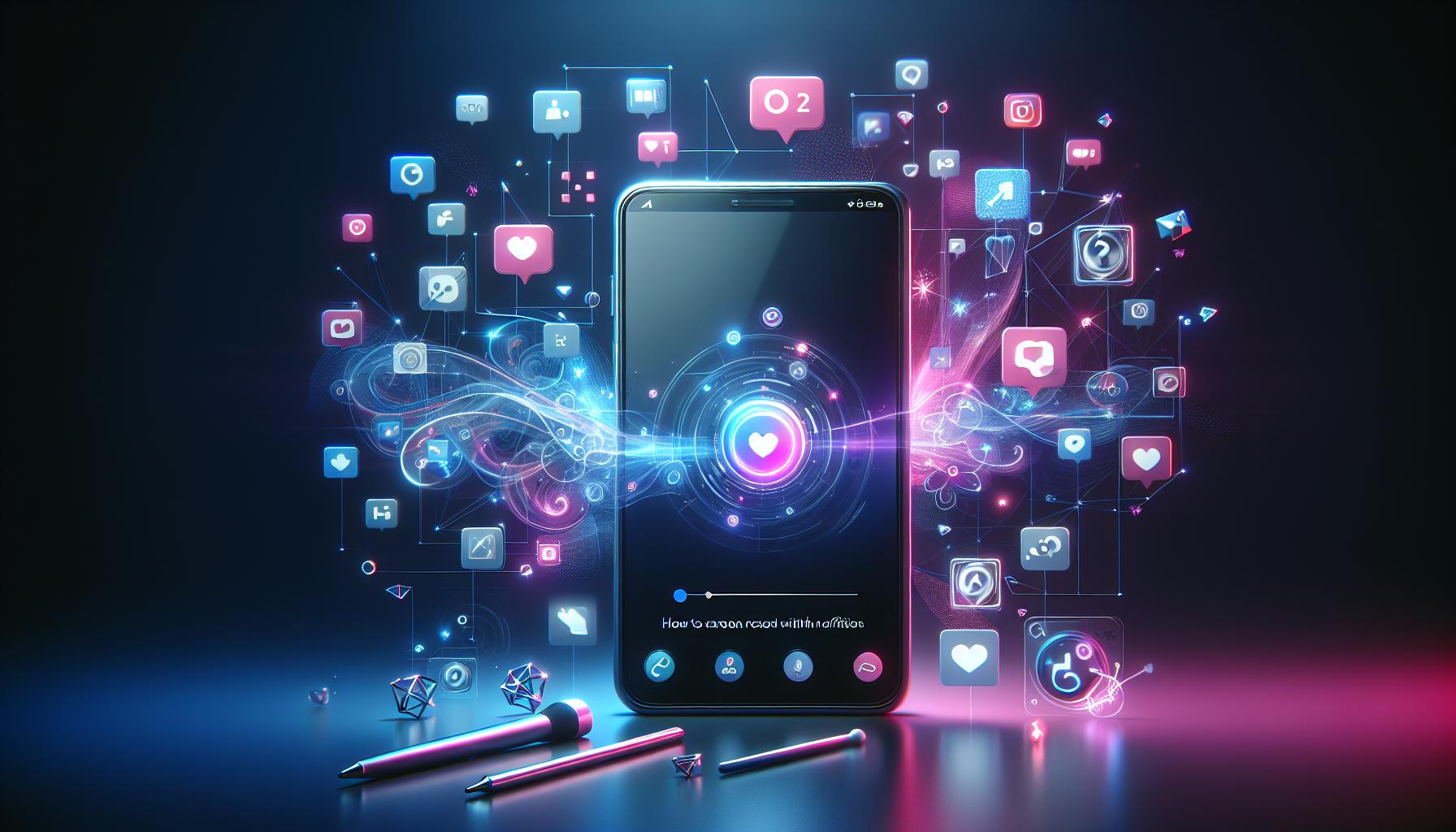In today’s fast-paced digital environment where privacy concerns are at an all-time high, understanding Instagram’s policies regarding screen recording can help you navigate the platform more confidently. Many users wonder whether Instagram notifies users when someone screens their Stories, especially given the ephemeral nature of the content.
This curiosity stems from a genuine desire to protect personal privacy while enjoying the unique features Instagram offers. While Instagram does not alert users when their Stories are screen recorded, there are nuances to be aware of, particularly with disappearing messages in direct chats. By clarifying these important privacy facts, you can feel secure in how you engage with Insta’s dynamic content.
Continue reading to uncover the details and equip yourself with knowledge that empowers your social media experience.
Does Instagram Notify Screen Recording? The Truth Revealed
Instagram does not notify users when someone records their Stories via screen capture. This common misconception often leads to confusion among users who believe that their content is being monitored more closely than it actually is. While Instagram offers various privacy features and settings, the act of screen recording is not flagged or communicated in any manner to the user whose story is being filmed.
When considering the implications of this, it’s crucial to acknowledge the importance of user consent and content sharing ethics on social media platforms. Although Instagram does not explicitly inform users about screen recordings, taking another user’s content without permission can violate community standards, and it’s often considered bad etiquette. Creators should remain vigilant about the content they post, especially knowing it can be recorded and shared without their knowledge.
If you’re looking to protect your stories, consider adjusting your privacy settings. Here are a few practical tips:
- Use Close Friends: Share Stories only with selected friends to limit who can see your content.
- Adjust Profile Privacy: Switch to a private account if you’re concerned about who can view your content.
- Monitor Engagement: Keep an eye on who interacts with your Stories, as frequent viewers may indicate potential risk.
This awareness of privacy settings can enhance your control over your content, giving you peace of mind in a platform where information can easily be shared or recorded without consent.
Understanding Instagram Story Privacy Settings
Understanding how your privacy settings work on Instagram is crucial, especially when it comes to sharing and viewing Stories. Instagram offers a variety of privacy options designed to enhance user control over who can see their content. While it’s easy to feel that your posts are safe, many users don’t realize the power and implications of their privacy settings.
To customize your Story visibility, start by navigating to your profile. Tap on the three horizontal lines in the top right corner, select Settings, and then go to Privacy. Here, you can adjust who can view your Stories through several features. For instance, the Close Friends list allows you to share Stories with a select group, ensuring that your content is only seen by those you trust. This feature is particularly useful for personal updates or sensitive content that you don’t want the public to see.
If safeguarding your content further is essential, consider switching your profile to private. This setting restricts access to your Stories and posts, ensuring that only approved followers can view them. You can also see who views your Stories, which helps you keep track of your audience and identify any potentially intrusive followers. Remember, frequent viewers may signal a risk of unwanted screen recording or sharing, so stay vigilant and reconsider your network if you notice any suspicious behavior.
Additionally, it’s important to familiarize yourself with Instagram’s community guidelines to avoid sharing content that could be flagged for inappropriate use. Engaging in responsible sharing practices fosters a safer online environment. By utilizing these privacy features and staying aware of who interacts with your content, you can enhance your control on Instagram and navigate the platform with confidence.
How to Screen Record Instagram Stories Without Notifications
Capturing Instagram Stories can be a common desire among users who want to save moments for later or share them with friends outside of the platform. While many wonder whether Instagram notifies users when their content is screen recorded, the app currently does not have a feature that alerts users about screen recording activities. This opens up opportunities to record Instagram Stories without facing notifications, provided you do it thoughtfully and responsibly.
To easily record Instagram Stories without raising eyebrows, follow these methods:
- Utilize Built-in Screen Recording: Most smartphones have a built-in screen recording feature. For iPhones, swipe down from the top right (or up from the bottom on older models) to access the Control Center, then tap the screen recording button. On Android devices, you can find the screen recorder in the quick settings menu. Be sure to start recording before you open the story you wish to capture.
- Use Screen Mirroring: If you have a smart TV or a device that supports screen mirroring, casting your phone screen to another display allows you to record from there without triggering notifications. This method can be particularly useful for high-resolution captures.
- Third-Party Screen Recording Apps: There are numerous apps available for both Android and iOS that are designed specifically for screen recording. Choose trustworthy applications with good reviews that do not compromise your device’s security. Remember to check the app permissions to ensure they respect your privacy.
Before recording, consider the ethical implications of saving someone’s content without their consent. While technical aspects allow for capturing Stories, respecting the original creator’s intention and privacy is essential. Always seek permission from content owners if you plan to share their Stories outside of Instagram. Adopting responsible sharing practices not only enhances the community experience but also shows respect for fellow creators’ rights. By navigating these methods successfully, you can engage with Instagram Stories in a way that is both effective and considerate.
Common Misconceptions About Instagram Screen Recording Alerts
Despite the prevalent rumors, Instagram does not notify users when someone records their stories. This misconception often stems from the platform’s robust privacy features, which have led users to assume that any form of capturing content would trigger an alert. In reality, the absence of notifications has created a unique dynamic where individuals can capture and save fleeting moments without the original poster knowing.
A common belief is that screen recording could lead to unwanted exposure or breaches of privacy. While it’s vital to be aware of the ethics surrounding content sharing, particularly when it involves another person’s creative work, the lack of notifications means that users are left in the dark regarding who might be saving their stories. This has sparked debates about respect for content creators and the implications of recording without consent. Users are encouraged to think critically about their intentions when capturing and sharing others’ content, especially in a community that thrives on authenticity and personal connections.
Furthermore, many assume that using third-party apps for screen recording will automatically flag their activities. However, similar to the built-in features of operating systems, these applications do not notify users when recordings are made. This means that whether one chooses to use their device’s built-in functionality or a specialized app, they can proceed without fear of triggering alerts. Nonetheless, it’s crucial to choose reputable applications that prioritize user privacy and security to avoid any potential abuses of personal data.
Ultimately, understanding these misconceptions allows users to navigate Instagram with greater awareness. Users should cultivate a responsible approach to content sharing, respecting creators’ rights and considering the impact of their actions within the platform. By holding these discussions, we not only empower ourselves but also enhance the integrity of community interactions on social media.
Exploring Instagram’s Data Privacy Policies
Instagram’s approach to data privacy is a critical component of its user experience, particularly as it relates to how content is shared, saved, and potentially recorded. Although the platform thrives on connection and sharing, it also recognizes the importance of protecting user data. Many users are often left wondering whether actions like screen recording prompt notifications or expose their privacy. Understanding Instagram’s data privacy policies can demystify this concern and empower users to navigate the platform more confidently.
Instagram firmly positions itself as a platform that values user privacy. This is reflected in its policies, which explicitly state that they do not notify users when others record their stories. This absence of alerts is rooted in Instagram’s technical architecture, focusing on user comfort and the instinct to share content without the interference of constant notifications. Users can capture moments without the original poster being immediately aware, which may lead to ethical dilemmas around consent but also fosters a sense of freedom in content creation.
To align with evolving privacy standards, Instagram regularly updates its privacy settings, providing users more control over who sees their content and how it is shared. For example, users can set their accounts to private, allowing them to approve who follows them and views their stories. This level of control can alleviate some privacy concerns, as it places the power to share in the hands of the content creator. Additionally, Instagram allows users to limit comments and messages from those not in their follower list, further enhancing their control over personal interactions.
However, while Instagram’s policies are designed to protect user data and foster a secure sharing environment, users must also be cognizant of the potential implications of their choices. When sharing stories or other content, consider who might record or take screenshots without notice. Users should remain informed about best practices for sharing sensitive or personal content, such as the importance of understanding the audience for each post and being mindful of engaging with unfamiliar accounts. With Instagram’s continuous development toward providing safety and privacy, users are encouraged to familiarize themselves with new features and updates-empowering them to use the platform effectively while safeguarding their interests.
What Happens When You Record a Story?
When individuals decide to record an Instagram Story, whether for personal reference or to share with others, the mechanics behind this action raise several questions about privacy and content ownership. Primarily, users often wonder about the implications of recording someone else’s story. It’s essential to clarify that Instagram does not notify users when their stories are recorded via screen capture. This lack of notification exists to provide a seamless user experience, allowing people to engage with content without the fear of constant alerts, which can disrupt the natural flow of sharing on the platform.
Upon recording a story, what exactly happens? The user recording the screen captures the content visually, potentially including all the viewer interactions, such as comments and reactions, displayed on the screen. However, the original poster remains unaware that their story has been recorded; thus, any surprise or concern about consent is complex. This ability to record comes with responsibilities. Users must consider the ethical implications of their actions. For instance, if sensitive content is being shared, and someone records it without the owner’s knowledge, it could lead to significant misunderstandings or violations of trust between users.
Moreover, it’s important to note that the content captured through screen recording can be reused or shared externally, thereby extending the reach of what might have been intended as a private moment. This can create scenarios where content is taken out of context, potentially harming relationships or reputations. Therefore, content creators should be mindful of what they share in their stories, as once it is posted, it can be recorded and shared far beyond the intended audience.
For users wanting to maintain control over their content, understanding the settings available on Instagram is crucial. By adjusting privacy settings-such as limiting who can view stories or switching to a private account-users can help mitigate the risks associated with screen recording. Keeping these factors in mind can empower Instagram users to make informed decisions, balancing their urge to share with the need to protect their digital identity and content.
Best Practices for Respecting User Privacy
Considering the growing concerns about privacy on social media, it’s essential to adopt strategies that protect both your own content and the rights of others while using platforms like Instagram. Understanding the nuances of content sharing, especially with features like Stories, is crucial in fostering a respectful online community. Notably, while Instagram does not inform users when their stories are recorded, there are proactive measures one can implement to promote user privacy.
One key practice is to be judicious about what you share in your Instagram Stories. Think before you post. If your content contains sensitive or private information, consider whether sharing it publicly is appropriate. Using the platform’s privacy settings can help protect your stories from unwanted eyes. You can limit who sees your story by using the “Hide Story From” option found under your “Privacy” settings. Additionally, switching your account to private restricts your audience solely to approved followers, minimizing the risk of unauthorized screen recordings.
Another vital aspect is to engage with your audience transparently. If you’re creating content designed for public consumption, make it clear that it’s intended for sharing. Conversely, if it’s meant to be private or intimate, communicate that directly within the post or through accompanying captions, urging viewers to respect your privacy. Encouraging a culture of respect and understanding within your community can significantly enhance user relationships and trust.
Finally, educating your audience about the potential implications of screen recording can be beneficial. Sharing posts or stories that highlight the importance of asking for permission before sharing someone else’s content not only sets a precedent but also empowers users to be more conscientious. Providing tips on respecting content creators’ rights fosters a safer environment for all Instagram users, aligning with the platform’s ethos of community and collaboration. By adopting these best practices, you can help create an engaging yet respectful space on Instagram, allowing creativity to flourish without compromising personal privacy.
Alternatives to Screen Recording Instagram Stories
Given the nuances surrounding privacy on Instagram, there are several that can help users capture content while respecting the original creator’s rights. While it’s tempting to capture a fleeting moment from a Story, there are ethical and practical ways to share or save content without resorting to screen recording.
To begin, consider using the built-in features that Instagram offers for saving content. When you see a Story that you enjoy, you might notice the “Add to your Story” option when the creator allows it. Tapping this feature enables you to share their Story directly with your audience, while giving credit to the original creator, fostering a sense of community and respect.
Another method is to utilize the Instagram screenshot function instead of recording. If there’s a particular frame in a Story that you want to save, taking a screenshot can be an effective alternative. Just remember to be mindful of the context-if the content contains sensitive information or was meant to be private, encourage a discussion with the creator before sharing it further.
Moreover, engaging with the creator directly can also be a valuable alternative. Consider sending a respectful message asking if you can save and share their content. Many creators appreciate this approach and might even provide you with additional content or perspectives to share.
Lastly, utilizing third-party apps designed for saving Instagram content can be beneficial. Apps like StorySaver or InstaSave allow you to download Stories directly to your device. However, it’s crucial to use these tools ethically by ensuring you have permission from the content creator before downloading and sharing their work. Striking a balance between enjoying the dynamic content Instagram offers and maintaining respect for privacy rights can encourage a more positive experience for everyone on the platform.
Navigating the Ethics of Content Sharing on Instagram
Navigating content sharing on Instagram requires a delicate balance between enjoyment and respect for creators’ rights. As users become more accustomed to sharing and consuming ephemeral content, the importance of ethical considerations grows. While it may be tempting to capture a fleeting moment from a Story using screen recording, understanding the implications of such actions is crucial. Engaging with content ethically not only protects creators but also enhances your reputation within the Instagram community.
One of the simplest ways to share content while respecting the original creator is to utilize Instagram’s built-in sharing features. For instance, the “Add to your Story” option allows you to repost someone’s Story while giving them credit. This practice not only acknowledges the creator’s effort but also encourages a culture of sharing that benefits everyone involved. Always prioritize creator consent when sharing, as this fosters a community of respect and collaboration.
When it comes to taking screenshots or screen recordings, consider the context and the creator’s intent. For example, if the Story contains sensitive information or was shared within a private context, it is essential to approach the creator first. A polite message asking for permission can lead to a deeper connection and possibly even future collaborations. Furthermore, educating yourself about third-party apps designed for saving Instagram content can also be beneficial. Tools like StorySaver or InstaSave allow the downloading of Stories, but always obtain permission before using them. By advocating for ethical sharing practices, you contribute to a safer, more respectful Instagram environment.
In summary, being mindful about how you share content on Instagram can significantly impact both your personal experience and the broader community. Acknowledging creators’ rights, using built-in features, and seeking consent not only demonstrate respect for their work but also enrich your interactions on the platform. Cultivating a culture of ethical content sharing transforms Instagram from a mere social media platform into a collaborative creative space where everyone thrives.
User Experiences: Screen Recording Stories Explained
When it comes to screen recording Instagram Stories, many users often wonder about the implications of their actions, particularly whether Instagram sends notifications when someone records their content. Currently, the answer is no-Instagram does not notify users if their stories are captured through screen recording. This lack of notification can lead to various user experiences, opinions, and feelings about privacy on the platform.
Many users express mixed feelings about recording Stories without the creator’s knowledge. For instance, while some may feel justified capturing fleeting moments, especially if the content is of personal significance, others are concerned about the ethical implications. A user named Sarah shares that she felt guilty after recording a friend’s private Story without asking for permission. She later learned that such actions could damage trust and relationships within her social circle. This highlights the importance of understanding the potential consequences of content capture-what may seem innocent could inadvertently breach personal boundaries.
In practice, managing how and when to screen record requires balancing the desire to hold onto a memory with a deep respect for the content creator’s intent. Users like Jake have opted for ethical sharing practices, preferring to ask for permission before recording or re-sharing content. His approach has garnered positive responses not just from friends but has also positioned him as a considerate member of the community. He suggests that initiating a simple conversation, such as, “Hey, can I record that funny story you just shared?” reinforces respect and often leads to better interactions.
Ultimately, user experiences around screen recording are shaped by a blend of personal values and the platform’s design. As Instagram continues to evolve, fostering a culture of consent and respect towards user-generated content will enhance the overall community atmosphere. Engaging in open dialogues about sharing practices can not only mitigate misunderstandings but also build stronger connections among users, ensuring a positive and respectful environment for everyone.
How Instagram Protects Content Creators’ Rights
The protection of content creators’ rights is a critical concern for Instagram as it navigates the complexities of digital sharing in an era plagued by privacy issues. Although Instagram does not notify users when their Stories are screen recorded, the platform has implemented various measures to safeguard creators and foster a respectful environment for content sharing. By focusing on user control and consent, Instagram aims to balance creativity with the autonomy of its community members.
User Control Over Content
One of the foundational principles of Instagram’s approach to protecting content creators is empowering users to manage their own content visibility. Creators can customize their privacy settings to determine who can see their Stories. For instance, adding followers to a “Close Friends” list allows creators to share content with a select audience, thereby enhancing privacy. Additionally, Instagram provides robust reporting features that enable users to report content that violates their rights or the platform’s community guidelines. This active involvement not only discourages unauthorized sharing but also reinforces a culture of accountability.
Community Guidelines and Copyright Policies
Instagram’s community guidelines explicitly prohibit the unauthorized use of another person’s content, reinforcing respect for intellectual property. For creators concerned about misuse of their content, the platform offers educational resources about copyright and fair use. Furthermore, Instagram collaborates with creators to help them understand their rights and encourages the proper attribution of shared content. By doing so, Instagram aims to deter free-riding behavior and promotes a healthier ecosystem where original creators can thrive.
Tools for Content Monetization
To further protect creators’ rights, Instagram has introduced monetization features that recognize and reward original content. By enabling creators to earn through ads placed on their videos or access exclusive content subscriptions, Instagram inherently advocates for the value of original work. These features not only incentivize creators to produce quality content but also help them feel secure that their contributions are valued and protected.
Conclusion
While users may screen record Stories without notifications, Instagram is committed to safeguarding the rights of creators through a combination of privacy controls, community enforcement, and monetization options. As the platform continues to innovate, the emphasis on user rights and creator empowerment will remain central to its mission. Engaging in transparent dialogues about privacy and content sharing practices can further strengthen this community, ensuring that all users feel respected and valued. Whether you are a casual user or a professional creator, understanding these protective measures can enhance your experience and interactions on Instagram.
Tips for Securing Your Own Stories from Being Recorded
While Instagram Stories offer a unique way to share fleeting moments with friends and followers, the worry about unauthorized screen recording can be quite distressing for content creators. Although Instagram currently does not notify you if someone screen records your story, there are strategic moves you can make to safeguard your content. Here are practical tips to help secure your stories and maintain the privacy of your creations.
To begin with, leveraging the “Close Friends” feature is a smart way to control who sees your stories. By adding followers to your Close Friends list, you restrict your story’s audience to a select group of individuals who you trust. This not only limits the chance of unwanted sharing but also creates a more intimate space for engagement. To set this up, tap on your profile, go to “Close Friends,” and add the users you want. It’s a simple, effective step that can greatly enhance your privacy.
Another layer of protection involves your account settings. Switching your account from public to private is a valuable strategy. When your account is private, only users you approve can follow you and see your stories, reducing the risk of unauthorized screen recording by strangers. To do this, go to your profile, tap on “Settings,” then “Privacy,” and toggle the private account option. This ensures that any followers who wish to see your content are vetted.
Additionally, consider posting less sensitive or personal content in your stories. If certain aspects of your life are particularly precious or vulnerable, it might be wise to keep them off Instagram altogether or share them through direct messages instead. This reduces the chances of these moments being recorded without your consent and allows for deeper connections without the fear of public exposure.
The use of engaging visuals and watermarking can also serve as a deterrent for unauthorized use of your content. Adding subtle watermarks to your images and videos not only asserts your ownership but also discourages others from repurposing your content without credit. To create a watermark, use editing tools to overlay your username or brand logo on your images before sharing them.
By adopting these strategies, you empower yourself as a content creator and protect your creative output. Staying informed about Instagram features and continually evolving your privacy practices will not only enhance your experience but also allow you to share confidently, knowing you’ve taken the necessary steps to secure your stories from unwanted recording.
FAQ
Q: Does Instagram notify users if you screen record their story?
A: No, Instagram does not notify users when someone screen records their story. As of now, there are no alerts or notifications related to screen recording, allowing users to capture stories without the content creator being aware. For more details on privacy settings, check the section on Understanding Instagram Story Privacy Settings.
Q: What happens if you screen record an Instagram story?
A: When you screen record an Instagram story, the original user does not receive any notification. However, while screen recording is possible, it’s essential to respect others’ content and their privacy. For best practices, refer to the section on Best Practices for Respecting User Privacy.
Q: Is screen recording Instagram stories legal?
A: Screen recording Instagram stories is generally legal for personal use, but sharing recorded content without permission may violate copyright and privacy laws. Always ask for permission before distributing any captured content. For more insights, see Exploring Instagram’s Data Privacy Policies.
Q: Can users find out if I’ve taken a screenshot of their story on Instagram?
A: No, Instagram currently does not notify users if someone takes a screenshot of their story. This feature was tested in the past, but it was removed. For more on this topic, review the section on Common Misconceptions About Instagram Screen Recording Alerts.
Q: Are there alternatives to screen recording Instagram stories?
A: Yes, consider using Instagram’s built-in features like saving posts to your collection or asking the user directly for access to their story content. It’s best to use these methods to respect users’ rights and privacy. See Alternatives to Screen Recording Instagram Stories for more suggestions.
Q: How can I prevent someone from screen recording my Instagram story?
A: While there’s no direct way to prevent screen recording, you can limit who sees your stories by setting your account to private or creating a close friends list. Learn more about privacy settings in Understanding Instagram Story Privacy Settings.
Q: Does Instagram provide any updates or notifications about privacy features?
A: Instagram occasionally updates its privacy features and policies, usually announced through official channels. It’s a good practice to stay informed by following Instagram’s official blog or help center. For further exploration, refer to Exploring Instagram’s Data Privacy Policies.
Q: What ethical considerations should be taken when recording Instagram stories?
A: Always consider the creator’s consent and the potential impact of sharing their content without permission. Respecting user privacy should be a priority. For a deeper understanding, refer to Navigating the Ethics of Content Sharing on Instagram.
Insights and Conclusions
Thanks for exploring the privacy aspects of Instagram Stories with us! Remember, while Instagram doesn’t notify users when you screen record a story, it’s essential to respect others’ content and privacy. For more insights, check out our articles on “How to Protect Your Instagram Privacy” and “Understanding Instagram’s Story Features.”
Now that you’re equipped with these privacy facts, why not dive deeper into your Instagram strategy? Explore our guide on maximizing engagement with your content to ensure you’re making the most of your presence on the platform. If you found this information helpful, consider subscribing to our newsletter for the latest updates and tips in the ever-changing world of social media.
We’d love to hear your thoughts-share your experiences in the comments below! Stay curious and keep creating!




